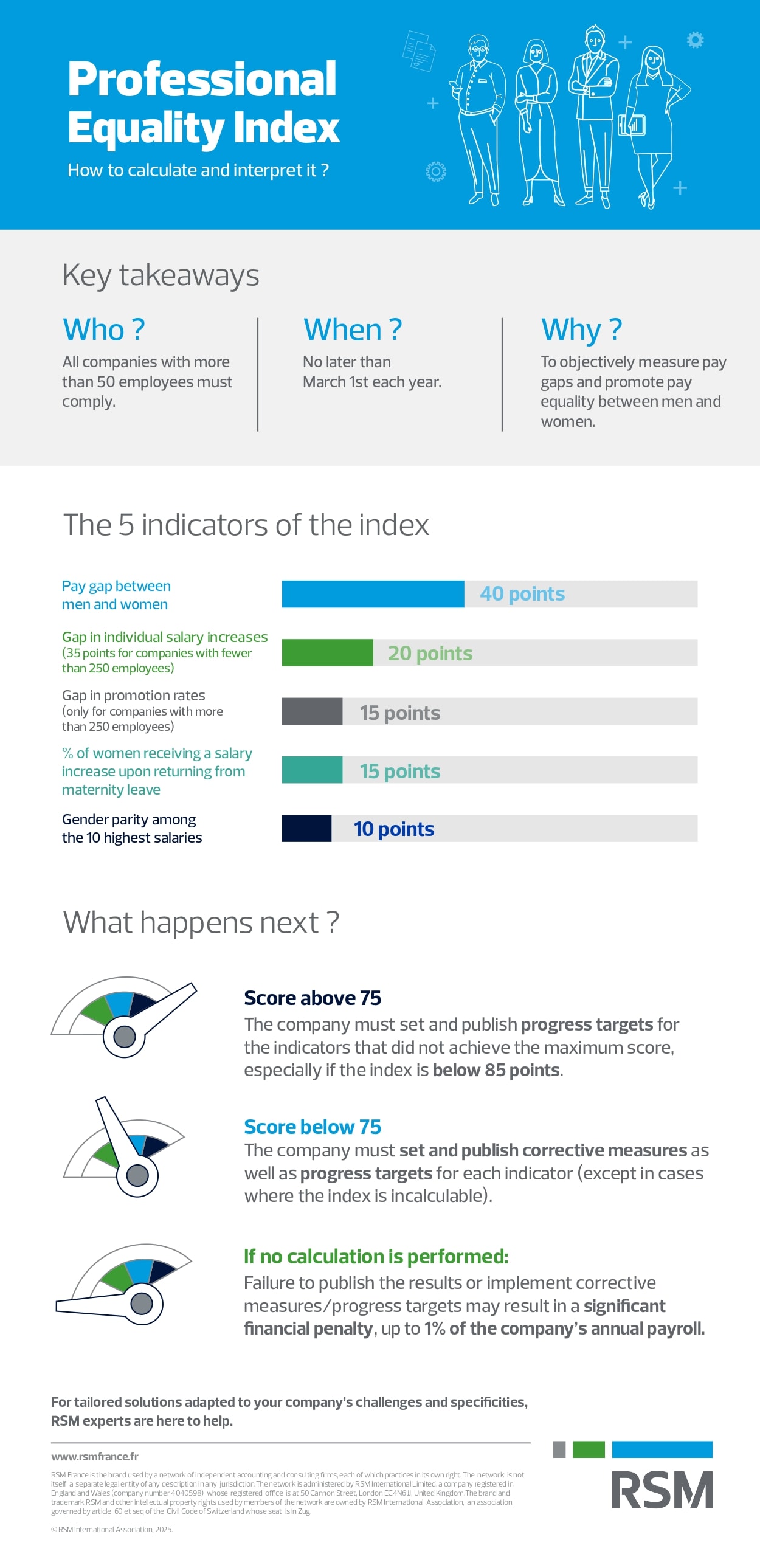Key Takeaways
The professional equality index between women and men, also known as the "Egapro index," is mandatory for companies with at least 50 employees.
Each year, before March 1, these companies must calculate and publish the result based on defined indicators.
In the case of an Economic and Social Unit (UES), the index is calculated at the level where the CSE has been established. For a group of companies, the indicator must be calculated at the level of each company exceeding the employee threshold.
Before calculating the Egapro index, it is essential to gather information. FAQ sections are available on the government website.
The Egapro Index in 4 steps every year
The legal obligation to be met is summarized in 4 steps:
- Calculate the index: That is, calculate the company's score out of 100 using 4 to 5 evaluation criteria.
- Declare the obtained score, and the detailed results of each indicator :
- On the company’s website accessible to the public.
If there is no website, the company must inform employees and job candidates individually by any means.
- On the Ministry of Labor’s platform called Egapro. - Integrate all these elements into the Economic, Social, and Environmental Database (BDESE) and communicate them to the company’s CSE..
- Improve:
1. If the index is below 75/100: the company must set and publish corrective measures and improvement objectives for each indicator.
2. If the index is below 85/100: the company must set and publish improvement objectives for the indicators that did not reach the maximum score.
What financial sanction applies for non-publication?
If the results are not published or if the result is below 75/100 for three consecutive years, the company faces a significant financial penalty that can reach up to 1% of its annual payroll.
[Our experts' advice] To mitigate this risk, in addition to simply complying with the legal obligation, it is crucial to understand the indicators to anticipate the impacts that each change in your compensation policy might have and consider them during negotiations with the employee representative bodies (IRP).
How to calculate and analyze the results?
Some tips before the calculation
Depending on the size of your company, the indicators may differ. For companies with 50 to 250 employees, there are only 4 indicators, while companies with more than 250 employees have 5 indicators.
The workforce to consider for the calculation of this index includes employees with an employment contract during the reference period chosen by the company. Employees who left the company before the end of the reference period but were present for more than 6 months are included.
Apprentices, professionalization contracts, employees assigned to the company, temporary workers, expatriates, employees absent for more than half of the reference period (continuously or intermittently), and employees in early retirement are excluded.
Also, it’s important to remember that the salary to be considered in the calculations is not simply the gross salary but the compensation in "full-time equivalent."
The indicators of the Egapro index
- The gender pay gap
This is the most important gap as it accounts for 40/100 of the final score.
Calculation
- The pay gap is calculated by classifying employees by professional category (workers, employees, TAM, and managers) and then by age group.
- The pay gap is reduced by a relevance threshold (5 points of relevance if the professional categories haven’t changed))
- The indicator can only be calculated if groups composed of at least 3 women and 3 men represent more than 40% of the workforce.
This means that a company hiring mostly employees of the same gender may have an uncalculable index because this first indicator could lower the score below 75.
Result
If this indicator’s result is poor, the corrective measure involves increasing the salaries of employees of the underrepresented gender and factoring this into recruitment decisions.
- The individual pay increase gap
This indicator accounts for 25% for companies with more than 250 employees and 35% for companies with fewer than 250 employees.
Calculation :
- The number or percentage of individuals of the same gender who received a raise.
Employees who received a promotion in companies with more than 250 employees are not counted.
Result:
If the result of this indicator is poor, significant attention should be given to salary increases, particularly ensuring that the proportion of women who received an increase is equivalent to the proportion of men who received an increase.
- The promotion gap
This indicator applies only to companies with more than 250 employees and accounts for 15/100.
Calculation :
- The number or percentage of individuals of the same gender promoted.
Result:
As with the previous indicator, if the result is poor, attention should be paid to promotions.
- The percentage of employees who received a raise in the year following their return from maternity leave
This indicator, which accounts for 15/100, is the simplest to understand but also the easiest to lose points on.
Calculation :
- If a raise occurred during the maternity leave period, all employees returning from maternity leave must also receive it.
Result
If no raise was given to all employees, including those returning from maternity leave, this indicator is uncalculable.
The score will be 0 if the company does not raise the salary of any employee returning from maternity leave.
- The number of employees from the underrepresented gender among the 10 highest-paid employees
This indicator accounts for 10/100 of the final score.
Calculation :
- This calculation is based on a very simple scale:
Equality or 4 employees from the underrepresented gender: score of 10
2 or 3 employees from the underrepresented gender: score of 5
Otherwise: 0
The Egapro index can be uncalculable
What makes the index uncalculable ?
There are several reasons related to the indicators that make the calculation impossible.
First, regarding the pay gap: if the proportion of women or men in the company is too unbalanced, the salary calculation becomes difficult. For example, the indicator is uncalculable in industries with a strong gender predominance, such as construction or aesthetics.
Next, the distribution of raises and promotions can render the index uncalculable due to the absence of promotions or raises during the reference period. If no significant movement has occurred in these areas, it is impossible to assess professional equality.
The indicator related to maternity leave can also be uncalculable as explained above.
What to do if the index is uncalculable ?
If the result is uncalculable, several options are considered based on the score obtained.
My index is below 75: What to do?
The index must not be published on the company’s website. No corrective action plan is required. However, the company must:
- Communicate the calculations to the CSE and the reasons for this uncalculability;
- Declare these results on the Ministry of Labor’s platform.
My index is above 75: What to do?
Apply a proportionality rule to bring the score back to 100. The legal obligations still apply.
This analysis is not exhaustive, but you now know the key factors impacting the Egapro index.
Finally, as a reminder, all companies with 50 employees or more must negotiate an agreement on professional equality every year, and in the absence of an agreement, a unilateral action plan must be implemented, regardless of the result obtained from the Egapro index.

With 5 years of experience supporting our clients in complying with this requirement to be declared every year before March 1st, our team of specialists, including payroll managers, labor law experts, and HRIS consultants, is available to assist and advise you in your HR processes.
Discover our in HR, social, and payroll consulting services.
- https://egapro.travail.gouv.fr/
- https://travail-emploi.gouv.fr/droit-du-travail/egalite-professionnelle-discrimination-et-harcelement/indexegapro#Le-tableur-de-calcul
- https://formation.lefebvre-dalloz.fr/actualite/index-egalite-femmes-hommes-principes-bilan-reforme
- https://www.gouvernement.fr/actualite/les-resultats-de-lindex-de-legalite-professionnelle-2023
- Giovanni Terrana, Directeur associé Conseil à Colmar
- Bertrand Dufour, Associé Expertise comptable à Lyon
- Luc Petiteau, Associé Conseil à Montpellier
- Cécile Guyot, Associée Juridique et fiscal à Colmar
- Vital Saint-Marc, Associé Expertise comptable à Paris
- Benoist Fournier, Associé Expertise comptable à Laval
- Jean-Marc Morel, Associé Conseil à Lyon
- Béatrice Belouet, Associée Expertise comptable à Paris



